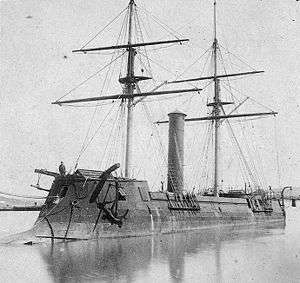Battle of Miyako Bay
| ||||||||||||||||||||||||||||||||

The Battle of Miyako Bay (宮古湾海戦 Miyakowan Kaisen) was a naval action on 6 May 1869. It was part of the overall Battle of Hakodate at the end of the Boshin War, a civil war in Japan between Imperial forces of the new Meiji government, and samurai loyalists to the former Tokugawa shogunate.
Preparations
The military forces loyal to the former Tokugawa shogunate were defeated by the Satchō Alliance at the Battle of Ueno and Battle of Aizu. With the Ōuetsu Reppan Dōmei in tatters, rather than surrender, a portion of the Tokugawa navy led by Admiral Enomoto Takeaki fled to the northern island of Hokkaidō, together with several thousand soldiers and a handful of French military advisors and established the Republic of Ezo.[1]
The new Imperial Japanese Navy departed Tokyo on 9 March 1869, and reached Miyako Bay in what is now the city of Miyako in central Iwate Prefecture, on 20 March. The imperial fleet had been rapidly constituted around the French-built ironclad warship Kōtetsu, which had been purchased from the United States. Other ships included Kasuga, ’’Hiryū, Teibō, Yōshun, and Mōshun, which had been supplied by the domains of Saga, Chōshū and Satsuma to the new central government in 1868. There were altogether eight Imperial ships: Kōtetsu, Kasuga, three small corvettes and three transport ships. Future commander in chief of the Imperial Japanese Navy, Tōgō Heihachirō was an officer on Kasuga during this battle
Anticipating the arrival of the Imperial fleet, the rebels organized a plan to seize the revolutionary new warship Kōtetsu, and dispatched three warships for a surprise attack:
- Kaiten ( flagship of the Republic of Ezo Navy) under the command of Arai Ikunosuke, and with the elite Shinsengumi, their leader Hijikata Toshizō, as well as the former French Navy military advisor Henri Nicol. Nicol had been selected for the attack since he was a native of Bordeaux, and knew the characteristics and construction of the revolutionary warship Kōtetsu, built in the same city.
- Banryū, with the elite Yūgekitai (遊撃隊) and former French Navy quartermaster Clateau, in charge of cannonry.
- Takao] (former Ashuelot) under command of ex-French Navy officer Eugène Collache, with the elite Shinkitai (伸木隊)].
The Ezo fleet encountered bad weather, in which Takao suffered from engine trouble, and Banryū became separated. Banryū eventually returned to Hokkaidō, without joining the battle.
Action
To create surprise, Kaiten planned to enter Miyako harbor under an American flag. Unable to achieve more than 3 knots (5.6 km/h) due to engine trouble, Takao trailed behind, and Kaiten first joined battle.
Kaiten approached the enemy ships and raised the Republic of Ezo flag seconds before boarding Kōtetsu. She rammed her prow into the side of Kōtetsu, and started firing her guns. Her deck however proved higher than that of Kōtetsu by close to three meters, forcing the samurai to jump one by one in a trickle. After the first surprise passed, Kōtetsu managed to repel the attack with a Gatling gun, causing huge losses to the attackers. Most of the attacking samurai perished; Nicol was hit by two bullets, and boarding party commander Kōga Gengo was killed and his position taken over by Admiral Arai Ikunosuke. In the action, Kaiten damaged three enemy warships, but finally disengaged without having captured Kōtetsu.
Kaiten steamed out of Miyako Bay pursued by the Imperial fleet (which had been warming up their engines even before the attack began), just as Takao was entering. Kaiten eventually escaped to Hokkaidō, but Takao was too slow to outdistance its pursuers and was beached at little distance from Miyako Bay, so that her crew could escape inland, and was scuttled by explosion. The 40 crewmen (including 30 samurai and the ex-French officer Eugène Collache) managed to flee for a few days, but finally surrendered to government forces. They were brought to Tokyo for imprisonment and trial. Although the fate of the Japanese rebels is unknown, Collache was eventually pardoned and deported back to France.
Conclusion
The Naval Battle of Miyako was a daring but desperate attempt by the Republic of Ezo forces to neutralize the powerful Kōtetsu. It was the first case of an abordage (boarding) maneuver in Japan. Although the attempt ended in failure, the loss of the Takao was marginal. The Imperial Navy continued north unimpeded, and supported landing and combat operations of thousands of government troops in the Battle of Hakodate.
References
- Collache, Eugène. "Une aventure au Japon" Le Tour du Monde, No. 77, 1874
- Evans, David; Mark Peattie (1997). Kaigun: Strategy, Tactics, and Technology in the Imperial Japanese Navy, 1887–1941. Annapolis, Maryland: Naval Institute Press. ISBN 0-87021-192-7.
- Gordon, Andrew (2003). A Modern History of Japan. New York: Oxford. ISBN 0-19-511060-9.


